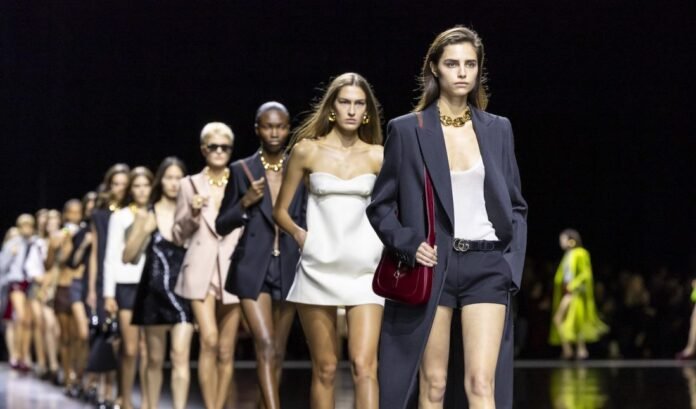The Hidden Cost of Couture: How Gucci & Versace Culture Is Damaging the Planet and Our Health
For years, brands like Gucci and Versace have set the gold standard for luxury—where velvet runways, diamond-studded accessories, and exclusivity were the ultimate markers of prestige. But what if behind all the glitz and glam lies a story that’s far less polished—a tale of environmental damage, chemical exposure, and psychological strain?
Welcome to the darker side of designer dreams, where the price tag isn’t just on the label—it’s also on our planet’s health and your own.
🌍 The Eco Fallout of Looking Fabulous
Let’s start with the earth. The fashion industry alone contributes around 3.6 billion metric tons of CO₂ annually, and luxury fashion, despite producing less volume than fast fashion, isn’t exactly innocent. Why?
Because luxury isn’t just about quantity—it’s about complexity. The sourcing of rare animal skins, the global supply chains spanning continents, and energy-guzzling production processes all come with a hidden environmental price.
💨 Carbon Footprint: Bigger Than It Looks
Take leather goods, for instance—a staple in Gucci’s collections. Leather production is linked with deforestation, methane emissions, and high chemical use. To produce one leather handbag, the process may involve up to 17,000 liters of water—enough to fill a small pool. Add in air freight, heating, tanning, and showroom lighting, and suddenly that “eco-luxe” branding begins to feel a little thin.
A 2024 Vogue Business report found that carbon emissions in fashion have actually increased, despite industry promises to go green. The luxury sector, with its “made in Italy” promise, often sources materials globally before assembling them in Europe—meaning more emissions and more ecological strain.
💔 Health Risks: When Style Comes at a Price
The allure of designer goods isn’t just about status—it’s about trust. We assume luxury means safety. But research says: not always.
🧪 Toxic Chemicals Lurking in Labels
Certain luxury products have been found to contain harmful substances like chromium VI (a tanning chemical), phthalates, and formaldehyde—which can cause skin irritation, respiratory issues, and long-term health damage.
Luxury doesn’t guarantee non-toxicity. In fact, the more “treated” or “refined” a product is, the more likely it may carry chemical residues. A report by Greenpeace found traces of hazardous chemicals in products from high-end brands including Versace. Shocking? Yes. Surprising? It shouldn’t be.
🧠 The Psychological Cost of Couture
Now let’s talk mental health—because not all harm is physical.
Luxury fashion thrives on aspiration, but that aspiration can quickly spiral into obsession. Constant exposure to curated influencer lifestyles, endless product launches, and the unspoken pressure to “keep up” can lead to emotional fatigue and financial stress.
In psychological terms, this is known as status anxiety—a condition where your self-worth becomes tied to what you can (or can’t) afford to wear.
🧠 Vocabulary Boost:
- Aspiration (noun): A strong desire to achieve something high or great.
- Multifaceted (adjective): Having many sides or aspects; complex or varied.
🛍️ Are Gucci & Versace Doing Anything About It?
Yes—and no.
👗 Gucci’s Efforts
Gucci has made notable steps toward sustainability:
- A fur-free policy since 2017.
- The launch of “Gucci Off The Grid”, a collection using recycled materials.
- A Circular Hub introduced in 2023 to rethink the way products are made and reused.
However, critics point out that many of Gucci’s core products—leather handbags, shoes, and accessories—still rely on environmentally harmful materials. So while the brand markets its green credentials, the impact remains partial.
👠 Versace’s Sustainability Moves
Versace, too, has dipped a toe into the green wave:
- Opened a LEED-certified store in London.
- Joined sustainability groups to audit and reduce its emissions.
- Reduced animal-based materials in some recent collections.
But again, these steps are not systemic. Transparency around sourcing and labor is still lacking. And for a brand that champions excess, minimalism doesn’t come easy.
🌿 So, What Can Consumers Do?
The truth is, you hold the real power. If we stop idolizing status and start valuing sustainability, brands will have no choice but to follow.
Here are small changes with big impact:
- 🛍️ Opt for ethically certified luxury brands or second-hand designer goods.
- 📱 Follow fashion watchdog platforms like Good On You to track how eco-friendly a brand really is.
- 🧵 Embrace slow fashion: invest in fewer, better-made pieces with timeless appeal.
🌎 Final Stitch: Can Style Save the Planet?
The glamor of luxury fashion is real. It’s cultural, emotional, and aspirational. But as we wake up to climate change, microplastic pollution, and mental health crises, we must ask: Is fashion’s cost worth the planet’s price?
Gucci and Versace may offer beauty and prestige—but unless they reinvent their DNA, that charm might turn toxic. It’s time for these houses of high fashion to build not just wardrobes—but a legacy of responsibility.
📌 TL;DR
- Luxury fashion brands contribute heavily to global emissions, waste, and biodiversity loss.
- Chemical exposure from leather and dyed fabrics poses real health risks.
- The pressure to “look luxury” can impact mental well-being and financial health.
- Gucci and Versace are taking steps—but far from truly sustainable.
- Consumers can drive change by demanding transparency, sustainability, and sanity in fashion.
Let me know if you’d like a featured image, infographic, or a version optimized for platforms like Medium or WordPress.


